Haltwhistle to Corbridge, 26 miles
First off this morning the wonderfully evocative name of Vindolanda. It was, until March 1973, just another fort – nicely enough preserved, and in a wonderful sheltered valley behind the wall – indeed behind the line of what is now known as Stanegate – the road that formed the lime (temporary border) before the wall was built. But it was then that the first of the writing tablets that have provided wonderful insight into wall life were found. (I’ve written before about the “birthday” invitation one that is usually on display in the British Museum.)
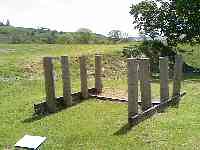 I won’t chart them in detail – this site does a wonderful job – except to note that they were found near these wooden markers for one of the gates of the early wooden fort (left) from which they date). But I will rave about many of the recently discovered objects on display in the museum. (No photos allowed unfortunately.)
I won’t chart them in detail – this site does a wonderful job – except to note that they were found near these wooden markers for one of the gates of the early wooden fort (left) from which they date). But I will rave about many of the recently discovered objects on display in the museum. (No photos allowed unfortunately.)
The sodden, anaerobic conditions allow the most remarkable things to survive – not just leather (“more than 1,000 items of footwear”) and a horse’s ceremonial leather headdress (chamefron), but even more remarkable are wigs/hairpieces made from local “hair-moss”. They look to me more like furry hats, but they are anyway astonishingly well preserved.
In 2001 they also found a helmet-crest made out of the same material – the only one known. They may have been decoration, unit identification or rank identification. Centurions wore them transverse across the skull, ordinary soldiers’ ran up from the line of their nose down to the back of their necks.
A narrow and finely proportioned horse skull – which fitted the chamefron perfectly – suggests Arab blood had been introduced into the Roman stock here.
There’s also the wonderfully tale-telling collection of 25 Samianware pots thrown together into an early ditch, along with a green glass bottle and a pot of oysters, most of which had not been opened, suggesting they had gone bad. The Samianware came from the pottery near modern-day Millau in France, and it is assumed the dishes were all found to have been broken in transit when they arrived in Vindolanda. And it seems not unreasonable to assume that an angry carrier threw them into the ditch in a temper.
As for the oysters – well had they survived the trip (and apparently they usually travelled quite well even in pre-refrig days), they would have been eaten (at least by the upper class at the fort) with special forks; about the length of your finger, with tiny double prongs on the end.
Textiles are all wool – the largest single-site collection from the western Roman empire. Some dyed red with madder, there’s a lichen-based purple, yellow easy with local barks or heather, adding an rusty nail would produce a nice green. Alum was used as a mordant.
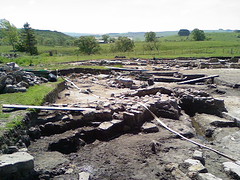
Throughout the spring and summer excavations continue. The 2006 excavation is at two sites. Near the top of the fort area (above) is a previous unknown timber fort from the end of the 1st century AD. It was demolished, clean clay layered over, on which were built a series of small stone shrines, to unknown deities. By late in the third century an aquaduct had been cut through the area. Immediately obvious are red terracotta pipes, but not to get too excited; they’re 19th-century field drainage.
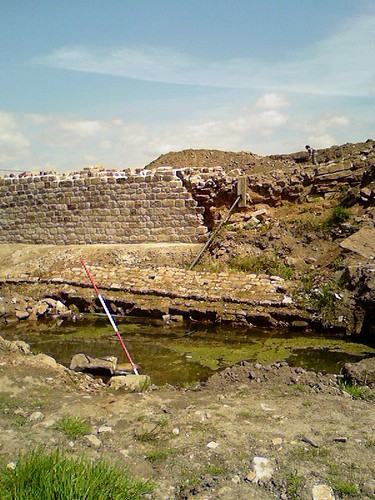
The other excavation is of the fort wall, two eras of it. One earlier wall lies on the ground (on the other side of the water), the later is standing although heavily tilted (and now held up with props). This will complete excavation of the circumference of the main stone forts.
(They do this every year, and take volunteers. Now there’s a thought for next summer…)
On the Stanegate road you pass the only known Roman milestone in its original position. It would have read “Coria (Corbridge) 20,000 paces (20 Roman miles)” – but cows rubbing on it have obliterated the text.
Actually I didn’t pass it, because my next destination was Housesteads fort, up on the wall, said to be one of the most scenic bits, where the wall does its Great Wall of China imitation …
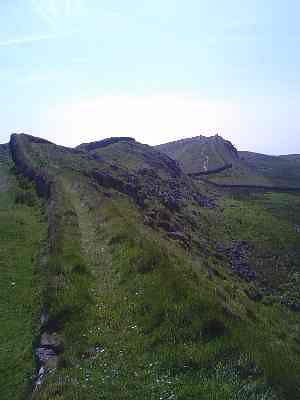
(Sorry you can see the limitations of the camera phone on which all these pics were taken in that image, but generally actually they turned out pretty well. And I don’t regret not bringing the weight of my ‘good’ camera along.)
That’s heading east from the fort; below is the view heading west. What’s rather fun about that is the depression that you can see on the crest of the first rise in that pick. A 19th-century antiquary got very exercised about that, imagining it to have been a small arena in which gladiatorial bouts were staged. Actually it is a quarry.
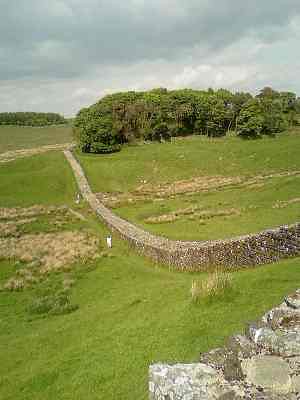
It is quite a trudge (on foot) up to the fort site (they only let disabled people drive, and a bicycle really wouldn’t help much). And my feet were dragging at the thought little run that came next. (After a rapid mechanical repair to the front brakes which had managed to become detached – thanks very much to the “real cyclist” (he’d been back and forth across the Penines for the day), never got his name, who helped me with that.)
It was into the wind – and up here you really feel the wind, and along the 18th-century military road, on which vehicles really zip along – but once I’d got off that and back on to Stanegate it was a glorious run into Corbridge – really zipping along with the wind behind me, engaging in fantasies of being a Roman dispatch rider with an urgent message about those pesky Brittunculli…
Reading around the wall, one of the amazing things is how little really is known about its construction. David Divine’s Hadrian’s Wall: The North-West Frontier of Rome has some rather eccentric theories – he seems to write as a military man, and comes up with some wonderfully detailed diagrams about exerting military power from it. But what I though most interesting was his thesis that Rome’s great strategic error was not to secure all of Britain, which forced it to maintain three legions in Britain, when one controlled all of Spain.
(That produces an interesting thought about alternative history. Imagine – the Roman empire is securely ensconced in Britain, and becomes the home of the real Western Roman Empire, as Constantinople did in the east … Has anyone written something along those lines? Anyone know?)
Yet the legions and auxiliaries on and near the wall were still vastly outnumbered by the local, and an account of the Vindolanda letters suggests that they provide an insight into how the Romans managed it – through a great deal of communication – with literacy extending right down to the ordinary auxiliary soldier (they seem to have written their own requests for leave, even if in sometimes uncertain hands). “The frontier line is not so much a system of continuous perimeter defence, nor even a symbolic division between Roman and non-Roman, but the basis of a continuous and active process of policing, organisation and control involving intensive exchange of information in the frontier zone itself and in the regional infrastructure in the year … Vindolanda above all reveals the extent and coherence of written communication. Without such communication the native Britons would conspicuously lack the ability to assess the strength and coherence of the opposition.” (p. 24) And I bet the soldiers spend a lot of time grumbling about the paperwork!
“The presence of these Tungrians and Batavians in northern Britain in c. AD100 is testimony to the huge investment, political, economic and cultural, which Rome had already made in northern Gaul and was in the process of making in northern Britain. … At the officer level, people like Flavius Cerialis exemplify the acculturation of the elites of the fringe regions who had much to gain from the acceptance of and compliance with Roman suzerainty. … Roman rule represented a relatively permanent and organised system which had an immense power to accumulate and absorb the local institutions.” (Life and Letters on the Roman Frontier, A.K. Bowman, British Museum Press, 1994, p. 31.)

 About
About
One comment
Pingback: Anonymous